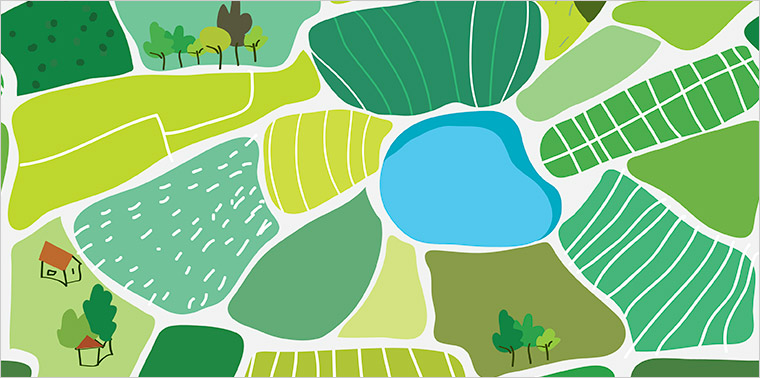March 3, 2017 —  Editor’s note: This Voices contribution is published in collaboration with the academic journal Elementa. It is based on “Leveraging agroecology for solutions in food, energy and water,” a peer-reviewed article published March 2, 2017, as part of Elementa’s Food-Energy-Water Systems: Opportunities at the Nexus forum.
Editor’s note: This Voices contribution is published in collaboration with the academic journal Elementa. It is based on “Leveraging agroecology for solutions in food, energy and water,” a peer-reviewed article published March 2, 2017, as part of Elementa’s Food-Energy-Water Systems: Opportunities at the Nexus forum.
The past several years have been rough for many U.S. farmers and ranchers. Net farm incomes this year could fall to 50 percent of 2013 levels in a fourth consecutive year of income declines that is leading some producers to seek alternatives. At the same time, rural and urban Americans share growing concerns related to agriculture: worries that water pollution will be increasingly costly and harmful, that water supplies are at risk from extreme swings in rainfall, and that global warming due to fossil fuel burning threatens our food system and will necessitate changes in how we farm.
What if all of these challenges could find a common solution? It might just be that they can. In a commentary published this week in the scientific journal Elementa, we contend that agroecology offers a promising approach to solving food system problems while mitigating, water and energy concerns — and propose a way to overcome the obstacles to fully embracing it.
U.S. agriculture has trended for several decades — as a result of policy, economics and other drivers — toward systems that are more simplified over both space and time. This has had adverse consequences for food, energy and water.
Agroecology takes a different approach, applying ecological concepts to create and maintain diverse, resilient food systems. Promising research demonstrates that bringing diversity back to farms can begin to reverse the problems simplification has created. For example, scientists have found that strategically incorporating perennial plants (including food, energy or non-crop plants) into small areas of commodity crops can significantly reduce water pollution and soil loss. Studies also show that using multiple crops rather than a monoculture is associated with improvements in the amount of carbon (important to help soils hold onto more water and mitigate climate change) and nitrogen (critical for plant growth and soil function) in the soil.
If better farming systems exist, why don’t more producers use them, and why aren’t they more encouraged? Among the reasons:
- Government policies and economics influence many producer decisions that contribute to landscape simplification. For example, biofuel incentives greatly expanded markets for ethanol, leading farmers to replace grasslands with endless acres of monoculture corn rather than leaving them native or planting more diverse crops.
- Research has also found that the need to focus on immediate cash flow rather than long-term benefits just to stay afloat can make it difficult to adopt more resilient systems
- Agroecology research is woefully underfunded. This means that up-to-date examples of innovative practices suited to specific regions are not sufficiently available for many farmers.
- Change is hard and it can take support for producers to get started. It is critical to find peers and peer networks to learn from — and these are rare.
- Benefits are narrowly defined. When farmers, policy-makers, and scientists focus primarily on simple measures of progress like crop yields, we lose track of the many other benefits of agroecology — including those related to water and energy.
In spite of these and other obstacles, innovators have begun to demonstrate that diversified land management can be good business, from a cover crop seed company in rural Nebraska, to a food hub supporting local diversified food production in western Iowa, to a consulting group helping farmers optimize land management and costs with a “precision conservation” approach. The dire need for economic opportunity in rural America was a major discussion point in the 2016 election, and these examples suggest how a more diverse and sustainable agriculture can help meet that need.
A shift in perspective that recognizes relationships among food, water, and energy systems and new metrics that value co-benefits to water and energy could go a long way toward further advancing agroecology. In fact, recently published research refutes the idea that we must solely focus on doubling crop production to meet future demand. These researchers believe the actual future yield increases needed are smaller and that we must explicitly define environmental goals to match the production demands that always seem to dominate the narrative around food.
Fortunately, we know that solutions do exist, and with agroecological approaches we can solve these multiple challenges at the same time. ![]()
Editor’s note: The views expressed here are those of the author and not necessarily of Ensia. We present them to further discussion around important topics. We encourage you to respond with a comment below, following our commenting guidelines, which can be found on this page. In addition, you might consider submitting a Voices piece of your own. See Ensia’s Contact page for submission guidelines.
Ensia shares solutions-focused stories free of charge through our online magazine and partner media. That means audiences around the world have ready access to stories that can — and do — help them shape a better future. If you value our work, please show your support today.
Yes, I'll support Ensia!


Clearly things are different where there are great cities; yet there is opportunity even there for growing, and this is already happening.
The reality is that farmers are under enormous pressure to produce at the cheapest price. Very few consumers will be happy to pay a whole lot more money for the same product just because it was produced on a farm with multiple cropping or livestock systems.
If you are a generalist, you face the risk of both losing out on economies of scale and not spending sufficient time with each cropping or livestock enterprise. This results in you spreading yourself too thin on all fronts (planning, production, marketing, selling and ensuring you get your money). Most farmers perform all these functions themselves. They will end up taking their eye off the ball and something will give.
Unless this dynamic can be changed, farmers will by and large continue to focus on what works and makes them the most money at the cheapest cost in terms of resources. This is not at the expense of the Environment, just maybe not using a theoretical measure of the way farming should look.